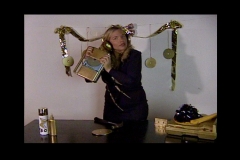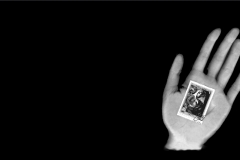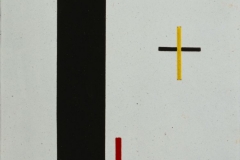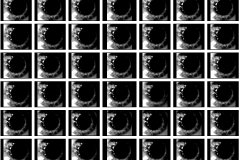Now that the internet has drowned in social networks and commercial channels, it makes sense to look back at the experiences of net art in the 1990s. This was an era of innocence, eagerness and heroes of a kind, when networks as art were brand new. Net art was both ironic and self-critical.
The essential difference is that the internet environment back then was something special and new, and now it is banal and everyday. In the 1990s, culture and art had to be, figuratively speaking, brought to the internet, settled there and only then was it possible to see how the environment influenced the content, whereas in the current post-digital and post-internet era, the internet environment is like nature: it surrounds us. It has become a channel through which the world reaches us, but it has also become an environment where people live their everyday lives, communicate and express themselves. It has turned into a dominating environment.
Twists of Internet-Based Art
What kinds of twists has the internet-based art trend gone through so far?
The term ‘net art’ was coined around 1996, and its explosive impact invaded several art festivals. The authors of net art projects experienced the birth of a new wave, which gradually flowed into the normality of events. The most significant names of the day were Alexei Shulgin, Olia Lialina, Jodi.org (Joan Heemskerk and Dirk Paesmans), Vuc Ćosić, Graham Harwood and Heath Bunting, and the theoreticians were Tilman Baumgärtel, Josephine Bosma, Geert Lovink and Pit Schultz among others(1). The brightest star was perhaps Shulgin, the author of the fictitious birth story of the term ‘net.art’. This was apparently the only comprehensible term in a confusing e-mail received by Vuc Ćosić in 1996.
Alexei Shulgin and Olia Lialina are the two most important names, the two who introduced themselves as Moscow born Russians and maintained their identities as Eastern-Europeans in the international history of 90s net art. Twenty years have passed since Olia Lialina’s well known work “My Boyfriend Came Back from the War”(2). Rhizome archives present this as Netscape Navigator Gold 3 browser emulation(3). Strangely, this work was never as emotionally effective as her “IF YOU WANT TO CLEAN YOUR SCREEN” (1996)(4). By moving the browser’s lower right scrollbar, you move the picture from the palm of a hand that seemingly wipes the screen from the other side. If you use an Apple Mac, the manipulation is even easier: move two fingers along the trackpad horizontally or vertically. A Soviet stamp showing a portrait of a woman holding a jar is attached to the palm. By clicking on the stamp, you can send an e-mail to Olia. The excitement in this project lies in making the net palpable, emphasised by the palm turned towards the viewer. It is still powerful stuff.
A work with a similar emotional potential in Estonian art is Laur Tiidemann’s “Piano” (2000). The screen shows eyeballs looping in two positions, and when you touch them you hear the sound of a piano. The project was initially created for the touch screen. This work won many international awards, for example, it received first prize in Tokyo in 2001 at “Art on the Net 2001. Post-Cagian Interactive Sounds”(5). Strictly speaking, this work should not even be on the internet, as there is no connectivity, but it nevertheless has an impact via connecting surreal eyeballs and touch.
Trains of Trends
How do trends emerge and develop? What is post-internet art, post-digital, post-media, post-contemporary, new aesthetics and contemporary contemporary?
When talking about trends, an Estonian artist faces a tormenting question: how to get your foot in the door, how not to ‘miss the train’, how to participate in art history? In the Estonian art world this is an obsession.The star of Estonian post-internet art, Katja Novitskova, advises going to the best art universities or visiting international artist residencies (6). The pragmatic shaping of an artist’s career and social activity do not take away from the pleasure an artist takes in creating art and self-expression. However, the obsessive idea of making it into the bigger picture remains, and is supposedly guaranteed by social sensitivity and practical creative work. The secondary activity of networking, not only online, but also in the offline world, is absolutely vital.
The biggest battles in Estonia took place in the 1990s, when organisations and funding schemes were worked out, which enabled artists to move around in the international arena. A relevant art life mainly relies on the competence of critic-curators and art historians, with few exceptions. The latter occurs in situations where the artist breaks into the international network independently. His autonomy, however, doesn’t survive. To acquire a voice, credibility and mediation, the artist needs a critic-curator-art historian who at worst will present him as his own achievement. This type of exploitation is quite rare. The relationship is symbiotic, both need each other as an artist has no time or wish to write about himself, and needs someone else to do that. A critic, on the other hand, needs living material to work with, someone he does not have to carry on his back: an artist functioning internationally.
When an artist who has made it operates independently, the critic, too, would like to be on the ‘train’ with the artist. The simplest method in Estonia is to curate work for the Venice Biennale. Katja Novitskova is certainly a good example, i.e. an internationally active artist with an Estonian background who is included in the nationally suitable curating context and is at the moment “one of the internationally most visible artists of Estonian origin”(7).
Returning to the topic of net art and post-internet, I’d like to suggest a tangible and simplifying claim in order to describe what has happened with net-based, non-material telecommunication art practice: it has become more spatial, object-based and physical, it has left the internet, the immaterial has become material, and the non-objectified has become objectified and commercialised.
From Net Art to Post-Internet – Development Curves
A rough development curve can be drawn from net art to post-internet art. The history of telecommunication and internet-based art practices contain the following tendencies; this is not necessarily a chronological division:
1) Preparatory stage in the 1970s -1980s in various places and continents, technically rather modest, but novel as far as innovation goes (projects by Roy Ascott, Robert Adrian, Douglas Davies, Nam June Paik and others).
2) Projects based on the real internet, first half and middle of the 1990s; birth of ‘net art’.
3) Software art and the generative art trend, partially coinciding with net art (Alexei Shulgin, Olga Goriunova and Amy Alexander).
4) Net art’s trend of becoming more physical with sculptural, architectural, performative and installation projects (still ongoing, in Estonia e.g. Timo Toots and his versions of “Memopol”; etoy.com, Heath Bunting’s projects, Paul Sermon’s telematic installations, Varvara & Mar’s “Binoculars to…Binoculars from…” and “Speed of Markets”.
5) The post-internet art trend, which emerged from the internet environment, but its contacts with net-based practice were indirect; the net experience and content became more physical: the second half of the 2000s to the present (Marisa Olson, Gene McHugh, Artie Vierkant and others).
This five-point division is only a sketchy illustration. From an art historical point of view, net art practices are linked with previous art tradition and movements, such as Dadaism and situationism, conceptual art, Fluxus, video art, kinetic art, performance art, telematic art and happenings. We should also not forget the prehistory of communicative art, such as László Moholy-Nagy’s “Telephone Pictures” in 1922 (8).
Another important chapter to acknowledge in the story of net art is the cyberfeminism movement in the second half of the 1990s, which was definitely net-based. A separate theme is also the issue of internet-based networks, particularly actively operating with Web 1.0. The situation regarding the current Web 2.0, favouring self-promotion, allows the usage of ready-made environments and the reshaping of them; paradoxically it does not assume much interference and personal contribution: communication takes place in the completed environment.
Internet-based artists’ networks in the second half of the 1990s significantly shaped the trends on which the artists worked; most importantly, they united Eastern and Western European artists. This was topical in the 1990s and motivation in both the East and the West was extremely high. Mailing lists appeared that united and shaped groups of artists: Nettime, Syndicate / SPECTRE, Faces, Doors of Perception, Xchange and 7-11. Rasa Smite (9) and Olga Goriunova (10) researched them while completing their PhDs. To summarize Smite’s conclusion, Web 2.0 provides excellent information about internet communities, its members and activities, but is not suitable for promoting collective ideas or organising the subject field.(11)
An Estonian example of a Web 1.0 based net community and discussion space is the mailing list “Latera”, established on the 24th of February 2000.(12) In its heyday it had over one hundred members. Discussions mainly focused on art politics. The fourth and fifth points coincide in some ways, net content morphs into palpable reality. During the ‘classical’ era (until 1999), net projects were tied to the web-based page, whereas now they have become spatial. In other words, websites have become, figuratively speaking, object-based and sculptural. On the other hand, we can see that the electronic and connective aspects have altogether disappeared from artworks, although they largely rely on visual elements acquired from the internet. This is made obvious in post-internet art.
Innovation, Conformism and Criticism
Although net art has been recorded in all respectable and established vehicles of art history, critical voices have been heard since its birth. In 1997 I interviewed Lev Manovich, Geert Lovink, Andreas Broeckmann and Alexei Shulgin, tentatively touching upon the emerging trend. The rising wave was clearly perceived, and there was excitement about what would follow and for how long. Shulgin answered the question about the highlight of existing net art by saying that it was more the passing of better days, and that was 20 years ago:
As the best epoch was the age of innocence, when the artists created for the joy of it and did not get paid, they only spent. Nor did they know whether they would actually produce anything worthwhile. The situation has changed. The era of competition is coming. An upheaval.(13)
Net activists back then were also asked whether this was conformism, if artists would do what was expected of them. The replies, especially by Geert Lovink and Alexei Shulgin, were mainly affirmative. We might wonder, however, whether these constitute universal mechanisms and repeated logic, on the basis of which art trends emerge and function. My hasty reply is of course affirmative, although the shaping of these trends and flows contains certain dynamics and fluctuations. As a result, works and names find their way into the pages of history, and will be preserved for decades.
Is it possible to talk about the same phenomenon in post-internet, i.e. that a certain collective phenomenon has emerged, a single-track way of thinking, a trend? Close social, technical and collective-psychological premises for this kind of attitude and analogical art productions have appeared. This is how it is, but it’s all valuable, as the art world constantly operates according to this logic, trying to produce idiosyncratic groups of artists who reflect what is happening in the world. Such things cannot be forced, or if they are it is very rare. Certain collective phenomena stay in a narrow niche, although they can survive for decades. This happened with the net art movement, which is now just a brand uniting the work of a handful of artists and, although others produced similar works, the list is closed. This is the unfair logic in how art history functions. The same can be predicted for the post-internet trend: the first dozen or so names at the top will remain there.
Post-Medium, Post-Media, The Post-Media Condition, Mainstream Contemporary Art (MCA) and New Media Art (NMA)
The above mentioned is a group of connected terms. The term ‘post-medium’ was used by Rosalind Krauss in her essay “A Voyage on the North Sea: Art in the Age of the Post-Medium Condition” in 1999.(14) Her objective was to reject the medium’s Greenbergian interpretation on the basis of works by Marcel Broodthaers. This in turn significantly differs from the earlier Félix Guattari definition of the term ‘post-media’, which he used as early as 1985 to characterise the new situation, meaning
post-(mass)-media, expressed in the blending of television, telematics and information technology, which actually happened over the course of the following decades.
The term ‘post-media’ was also used by Lev Manovich in 2001. In his article “Post-Media Aesthetics”(15), he wrote that the traditional concept of media no longer worked in a post-digital, post-net culture: “…the traditional strong link between the identity of an art object and its medium becomes broken.” Everything is reduced to the same digital bases, the common denominator.
“The Post-Media Condition” is the title of an exhibition curated by Peter Weibel in 2006 and an essay from the same year.(16) In his interpretation, the ‘post-media’ situation is the situation of all contemporary art; even painting and sculpture are influenced by the new media:
Hence in art there is no longer anything beyond the media. No-one can escape from the media. There is no longer any painting outside and beyond the media experience. There is no longer any sculpture outside and beyond the media experience. There is no longer any photography outside and beyond the media experience. (17)
Mainstream contemporary art (MCA) and new media art (NMA) were terms used by Edward Shanken in a 2010 article, “Contemporary Art and New Media: Toward a Hybrid Discourse?”(18) Shanken complains about the absence of a joint field of discussion between mainstream contemporary art (MCA) and the new media art (NMA). To alleviate the situation, during Art Basel in 2010 he organised a conversation between the influential curators Nicolas Bourriaud and Peter Weibel (the artist Michael Joaquin Grey took part as well, and talked about his works).(19) Bourriaud, who has always been sceptical of new media, claimed that as the new technology was directly influenced by connectivity and, being based on networks, it was possible to create social situations that had been impossible before. Another significant impact of the new technology, in his opinion, was the screen format, presenting images on screen. He also considered technological impacts on contemporary art to be indirect, in the same way as photography influenced impressionism.
Weibel repeated the views expressed in his 2006 essay The Post-Media Condition claiming that the new media has had an impact on the entire new art situation, including traditional arts. The term ‘modern art’ has been replaced by ‘contemporary art’, primarily because of the influences of new technology. A few decades earlier the term ‘modern art’ would have been used at such an encounter, according to the curator. It is uncertain whether this encounter produced the intended hybrid discourse, in which the representatives of both sides (MCA and NMA) reached mutual understanding.(20)
The most significant mistake that is made regarding new media-based art is to see it as a medium in the sense of a mediator, that it conveys some kind of other reality, translated through a digital code, information of analogous reality, and is then re-mediated. A certain context arises from the characteristics of the phenomenon itself: such as its materialism and technical qualities. The digital environment is not just the transfer medium, the mediator medium, the re-mediator. Various art forms emerging on these platform (interactive art, net art, software art, telecommunicative art, bioart and other hybrid formats) also possess their own set of rules, which understandably rely on the character of the digital environment and technology, but are essentially innovative. This is not merely technology as a tool, a medium and a means with which to differently package existing reality; it has created a different kind of playing field where the previous conventions of physical art and reality are no longer valid.
At the same time, this field requires some technical knowledge. The 1990s could be characterised as an era of establishing new media centres, with media labs of all kinds, and university new media subunits. However it seems the enthusiasm has waned for artists to acquire the necessary technical knowledge and skills for digital work. This may be because the attraction, edginess and ‘sexiness’ of new media have decreased, partly because digital technology is everywhere, and partly because purely technical education does not really suit art academies: the cognitive abilities of creative people are limited and they require more intuitive creative practices than technical training involving discrete intellectual abilities. This all constitutes fertile ground for the decisive backlash known as ‘post-internet’.
Before comparing post-internet definitions, I suggest the hypothesis that on the whole the post-internet art movement can be viewed as a reaction against the specially skilled, cognitive demands of technical art and at the same time accommodate the system of contemporary art: producing physical artefacts. The term post-internet was apparently first used by Marisa Olson in 2006. As the editor of the net portal Rhizome, she held quite an influential position. While producing her own projects, she saw post-internet as the phenomenon of ‘internet-engaged art’, or net-influenced visual art. Olson’s updated view on post-internet (in 2014) was: “Today I use the term more broadly to think about the social conditions of life in network culture.”(21)
Post-Internet Definitions
Constant Dullaart: “A conventional, perhaps even nostalgic object-oriented art practice, based on commercial aesthetics propagated on social networks and in advertising.”(22)
Brian Droitcour: “’I know it when I see it’ — like porn, right? And it’s not a bad analogy, because post-internet art does to art what porn does to sex… How can we be post-internet when the internet is still here? Shouldn’t it be during-internet.”(23)
Harry Burke: “’Post-internet’ is reminiscent of a network of art practices that began to develop a critical currency in 2009 and mainstreamed (in the art world) in 2011 and (outside the art world) in 2012.”(24)
Esther Choi: “I would define ‘post-internet’ in the broadest terms, as a set of modalities and sensibilities that self-referentially respond to the Internet’s advent and cultural influence.”(25)
Lauren Cornell claimed that ‘post-internet art’ was an attempt to recapture internet art for gallery culture.(26)
Raffael Dörig: “Now that post-internet has become a label (that everybody from its first generation hates) that made it easier for the art market and the mainstream art world to talk — as a new ‘trend’ — about a group of people who work with the internet (the internet! you know, this new medium) but luckily also produce objects. This is not necessarily a bad thing, but creates weird situations sometimes when it’s completely ignored that there was/is internet art or net-related art before/outside post-internet.”(27)
Ann Hirsch: “Originally post-internet meant an awareness of how the internet has fully permeated our lives. From daily mundane functions to relationships to the way we perceive culture and the way it is being spread.”(28)
Paddy Johnson: “Art post-internet describes post-internet as a state of mind — to think in the fashion of the network. Artwork reflects the network within which it is created. (Employs the language of advertising, graphic design, corporate branding, etc.)”(29)
Omar Kholeif: “I tend to adopt the common notion that post-internet is art that is ‘internet aware’ so it is not necessarily medium-specific nor does it prescribe to any particular formal idea but it is art that is critically engaged with the internet as an all-encompassing social and political medium.”(30)
Nik Kosmas: “post-internet was the stuff that came after net art, (neen, rozendaal, jodi), post-internet art doesn’t fetishize the media, it’s about the experience of living, networked, in 2k1 century.”(31)
Christiane Paul: “While I don’t like the term post-internet, I don’t think it has had a negative effect on the mainstream art world. Post-internet works fare much better on the art market than ‘new media art’ per se, but I think this success can be attributed more to the fact that it largely takes the form of objects rather than the post-internet discussion.”(32)
“I think it would be highly problematic to claim that there is a progression from Internet art to post-internet art.”(33)
Lance Wakeling: “I think post-internet is the morning after the honeymoon of the marriage between the digital and the real. It is a fleeting, temporal marker for the beauty and horror that will follow.”(34)
In summary, this selection of opinions demonstrates internet-aware creative practices, which have found positive feedback in the system of contemporary art, oriented toward artefacts, physical art, the field of contemporary art and art fairs. Post-internet does not really have much to do with earlier digital art practices. This, of course, does not mean that people do not possess digital art and net art awareness, besides internet-awareness.(35)
Predicting the future is a thankless job, but the discussion at the beginning of the article about the essence of trends and their duration makes one think of the possible future of post-internet art.(36) As some authors have mentioned, it is positive that post-internet has introduced media-awareness into the discussions of contemporary art. Before, mainstream contemporary art (MCA) had been relatively separated from new media art (NMA). Perhaps at least a bridge has now been established that allows some traffic flow.
- Tilman Baumgärtel’s “Net.Art.2.0: New Materials Towards Net Art” was published in Estonian in 2006.
- http://www.teleportacia.org/war/ (visited 24.01. 2017).
- Olia Lialina. My Boyfriend Came Back from the War, 1996, https://anthology.rhizome.org/my-boyfriend-came-back-from-the-war (visited 24.01. 2017).
- http://www.entropy8zuper.org/possession/olialia/olialia.htm (visited 24.01. 2017).
- “Art on the Net 2001” “Post-Cagian Interactive Sounds”, Machida City Museum of Graphic Arts, Tokyo (MCMOGATK), http://www.netarts.org/mcmogatk/2001/awards.html (visited 24. I 2017).
- Juhend läbimurdeks kunstimaailma (Instructions for Breaking Through To The World of Art), Eesti Päevaleht, 9 July 2013, http://epl.delfi.ee/news/kultuur/juhend-labimurdeks-kunstimaailma?id=66413008 (visited 24.01.2017).
- Kati Ilves. Loodus ja Loomad. Katja Novitskova vahendatud reaalsuse representatsioonid. (Nature and Animals. Representations of Reality Mediated by Katja Novitskova) — Vikerkaar 3/2014, p. 95.
- I have touched on the history of net art and the part Estonian artists played in it, in my doctoral thesis “Postmateriality in Art” (Eesti Kunstiakadeemia, 2009) in the chapter “Netikunstist”, pp 201-221.
- Rasa Smite. Creative Networks, in the Rearview Mirror of Eastern European History. Institute of Network Cultures, Amsterdam 2012,
- Olga Goriunova. Art Platforms and Cultural Production on the Internet. Routledge, 2012.
- Rasa Smite. Creative Network Communities in the Translocal Space of Digital Networks. Human Technology, An Interdisciplinary Journal on Humans in ICT Environments, Volume 9(1), May 2013, 19.
- Raivo Kelomees. Maililisti „Latera“ kõnelemisruum. Eesti kunsti sotsiaalsed portreed. Lisandusi Eesti kunstiloole. (Talking Space of The Mailing List “Latera”. Social Portraits of Estonian Art. Additions to Estonian Art History.) Kaasaegse Kunsti Eesti Keskus, 2003, pp 24-55.
- Raivo Kelomees. Interview with Alexei Shulgin in September 1997 at Ars Electronica in Linz, Austria. Recording courtesy of the author.
- Rosalind Krauss. A Voyage on the North Sea: Art in the Age of the Post-Medium Condition. London: Thames & Hudson, 1999.
- Lev Manovich, Post-Media Aesthetics, http://manovich.net/content/04-projects/032-post-media-aesthetics/29_article_2001.pdf (visited 24. 01 2017).
- Peter Weibel, THE POST-MEDIA CONDITION (2006), http://www.metamute.org/editorial/lab/post-media-condition (visited 24. 01 2017).
- Ibid.
- https://artexetra.files.wordpress.com/2009/02/shanken-hybrid-discourse-draft-0-2.pdf (visited 24. I 2017).
- Art Basel, Salon | Art and Technology | Contemporary Art and New Media: Towards a Hybrid Discourse, Edward Shanken, Nicolas Bourriaud, Michael Joaquin Grey, Peter Weibel, https://www.youtube.com/watch?v=9p9VP1r2vc4 (visited 24.01. 2017).
- Ibid.
- Art Post-Internet. Catalogue. Edited by Karen Archey and Robin Peckham. Ullens Center for Contemporary Art in Beijing, 2014, 95, available online at http://post-inter.net/ (visited 24.01. 2017).
- Ibid, 92.
- Brian Droitcour, Why I Hate Post-Internet Art, 2014, https://culturetwo.wordpress.com/2014/03/31/why-i-hate-post-internet-art/ (visited 24.01. 2017).
- Art Post-Internet, 87.
- Ibid, 87.
- Ibid, 88.
- Ibid, 88.
- Ibid, 92.
- Ibid, 93.
- Ibid, 93.
- Ibid, 93.
- Ibid, 124.
- Ibid, 96.
- Ibid, 98.
- Regine Debatty, “Interview with Marisa Olson”, We Make Money Not Art, March 28, 2008, http://we-make-money-not-art.com/how_does_one_become_marisa/
- Domenico Quaranta in Art Post-Internet, 125.




